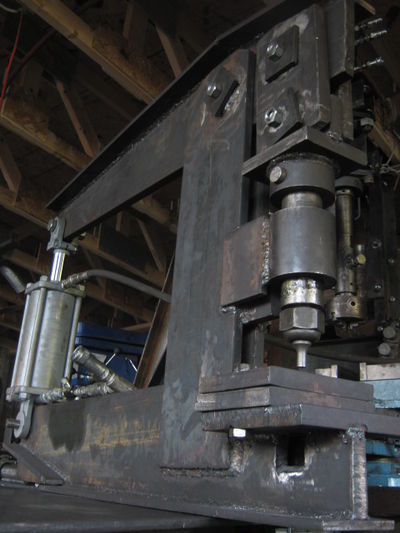Ironworker: Difference between revisions
Jump to navigation
Jump to search

(Adding version-specific pages) |
(Added a Category to the Page) |
||
| (8 intermediate revisions by 3 users not shown) | |||
| Line 1: | Line 1: | ||
{{OrigLang}} | |||
{{GVCS Header}} | |||
[[Image:Ironworker.jpg|thumb|400px|Ironworker | [[Image:Ironworker.jpg|thumb|right|400px|Ironworker hole puncher, built at OSE in 2010. See [https://www.opensourceecology.org/open-source-150-ton-hole-puncher/ blog post].]] | ||
=Overview= | |||
Ironworker machines can shear, punch holes and notch in steel plates. | |||
=Versions= | =Versions= | ||
See [[Ironworker Genealogy]]. | |||
=Details= | =Details= | ||
An Ironworker is a fundamental machine for working with many and is the backbone of many fabrication workshops. It generates tremendous force using hydraulic systems and mechanical leverage. | |||
=Product Ecology= | =Product Ecology= | ||
'''Uses''' | '''Uses''' | ||
| Line 109: | Line 30: | ||
See [[Product Ecologies]] for more information. | See [[Product Ecologies]] for more information. | ||
== | =See Also= | ||
*[[Hole Puncher Die]] | *[[Hole Puncher Die]] | ||
*[[120 Ton Hole Puncher]] | *[[120 Ton Hole Puncher]] | ||
*[http://blog.opensourceecology.org/2010/07/open-source-150-ton-hole-puncher/ Blog Announcement] | *[http://blog.opensourceecology.org/2010/07/open-source-150-ton-hole-puncher/ Blog Announcement] | ||
[[Category: | [[Category:Hole Puncher]] [[Category: Metalworks]] [[Category: RepLab]] | ||
[[Category: | |||
Latest revision as of 21:02, 8 July 2021
| Ironworker | ||
|---|---|---|
| Home | Research & Development | Bill of Materials | Manufacturing Instructions | User's Manual | User Reviews | 
| |

Ironworker hole puncher, built at OSE in 2010. See blog post.
Overview
Ironworker machines can shear, punch holes and notch in steel plates.
Versions
See Ironworker Genealogy.
Details
An Ironworker is a fundamental machine for working with many and is the backbone of many fabrication workshops. It generates tremendous force using hydraulic systems and mechanical leverage.
Product Ecology
Uses
 Induction Furnace Steel
Induction Furnace Steel Welder parts
Welder parts
Creates
See Product Ecologies for more information.

